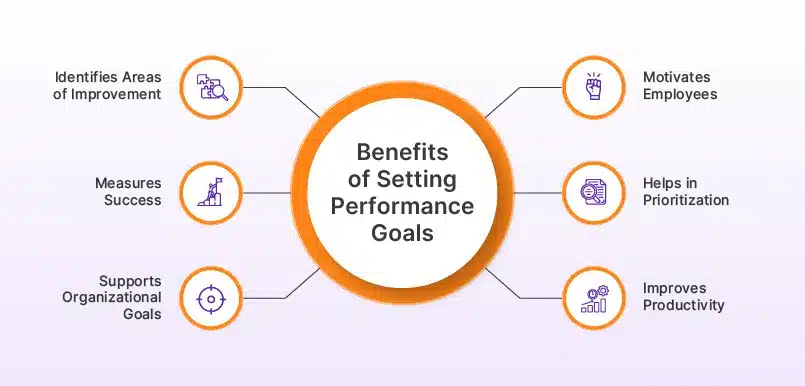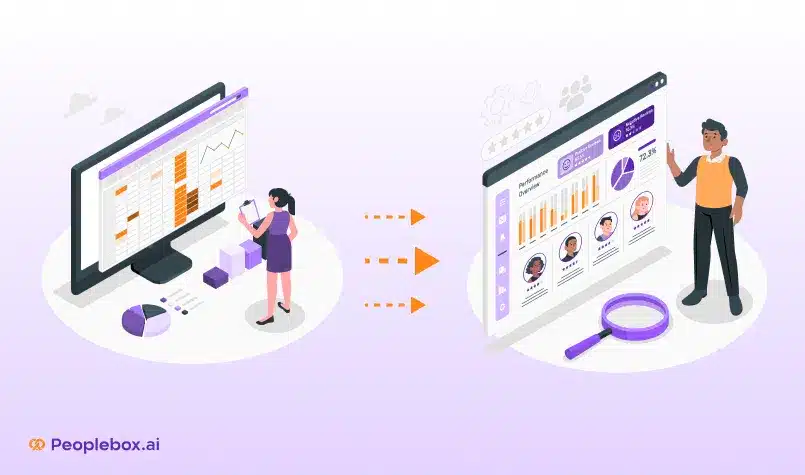Effective performance goals are crucial for driving excellence and fostering growth within any organization. By setting clear and measurable goals, both employees and managers can focus their efforts on achieving key objectives that enhance productivity, improve job satisfaction, and contribute to the company’s overall success.
A study by Gallup found that companies implementing performance goals for their employees experience a 17% increase in productivity, a 23% rise in profitability, and a 10% improvement in customer satisfaction.
In this post, we discuss 20 employee performance goals examples that go beyond the basics, offering insights and inspiration for managers and employees alike. These goals are designed to nurture talent, encourage collaboration, and align individual aspirations with organizational objectives.
Let’s get started!

What Are Performance Goals?
Performance management goals, often referred to as performance goals or key performance indicators (KPIs), are specific and measurable objectives established by individuals or teams within an organization.
Performance goals are designed to enhance individual and collective performance in the workplace by providing clear targets and a structured framework for improvement.
What are the Benefits of Performance Goals?
The importance of performance goals cannot be overstated, as they serve several important functions:

💪 Motivates Employees
Performance goals act as powerful motivators. They offer employees clear, attainable targets to strive for, igniting their motivation to excel in their respective roles.
When employees have a well-defined goal to work towards, they often find increased satisfaction in their work and a stronger sense of purpose.
📑 Helps in Prioritization
Tasks and projects can quickly become overwhelming. Performance goals help employees and teams prioritize their efforts by directing their focus toward objectives that align with organizational priorities. This ensures that time and resources are allocated to the tasks that matter most.
📈 Improves Productivity
Clear and well-structured goals have a remarkable impact on productivity. They give employees a sense of direction and purpose, reducing ambiguity about what needs to be accomplished. As a result, employees can work more efficiently, making measurable progress toward their goals.
🔍 Identifies Areas of Improvement
Performance goals serve as diagnostic tools to identify areas of improvement. By setting specific objectives, employees and managers can identify areas where skills or performance may need enhancement. This self-awareness is invaluable for personal and professional growth.
🏆 Measures Success
One of the fundamental purposes of employee performance goals is to create a yardstick for success. With clearly defined objectives and measurable key results, progress can be gauged accurately. Employees can track their accomplishments and determine whether they are on the right track to meet their goals.
🎯 Supports Organizational Goals
Individual and team performance goals are not isolated endeavours but integral to an organization’s success. When employees’ goals align with the company’s broader objectives, it creates a cohesive and purpose-driven workforce. This alignment ensures that every action taken at the individual level contributes to the organization’s overall success.
What are the Different Types of Performance Goals Frameworks?
Different performance goals frameworks cater to varying needs and preferences, ensuring alignment between individual performance goals and organizational objectives. Here are some common types:
1. SMART Goals
SMART is a widely used goal-setting framework that stands for Specific, Measurable, Achievable, Relevant, and Time-bound. It helps create clear, actionable employee goals by defining exactly what needs to be accomplished, how it will be measured, and by when.
2. Goal Pyramid
The Goal Pyramid is a hierarchical approach that breaks down high-level goals into smaller, more manageable objectives. It aligns individual goals with team and organizational goals, ensuring everyone is working towards the same vision.
3. The BHAG Goals Methodology
The BHAG Goals Methodology, or Big Hairy Audacious Goals, are ambitious, long-term goals that stretch an organization’s capabilities and resources. They provide a clear focus, drive innovation, and inspire employees to achieve more than they thought possible.
4. OKRs
OKRs, or Objectives and Key Results, are a popular goal-setting framework used by companies like Google (we talk all about it in our definitive guide to Google’s OKR playbook), Intel, and Adobe. OKRs involve setting a bold objective along with 3-5 measurable key results that track progress. The main advantages of using OKRs include:
✅ Improved Alignment: OKRs ensure that everyone in the organization is working towards the same objectives.
✅ Increased Transparency: Key results provide clear performance metrics for measuring progress, fostering transparency and accountability.
✅ Enhanced Focus: OKRs help teams and individuals stay focused on what matters most, driving productivity and efficiency.
With Peoplebox, you can easily set, track, and manage your OKRs in one intuitive platform, simplifying the goal-setting process for everyone in your organization. Want to see how? Try it yourself!
Using OKRs to Align Individual Performance Goals with Organizational Objectives
Individual goals must be closely aligned with the broader objectives of the organization. This alignment not only ensures that everyone within the company is in the same direction but also enhances the organization’s ability to achieve its overarching goals. One highly effective framework for achieving this synchronization is OKRs.
OKRs (Objectives and Key Results) help you break down larger objectives into different goals and milestones. They are designed to provide clarity, focus, and alignment across all levels of an organization. Objectives define what you want to achieve, while Key Results specify how you will measure progress towards that objective.
Now, let’s explore 20 performance goals examples, which you can use as templates or adapt to your specific organizational context with the right performance management tools:
20 Effective Performance Goals Examples for Employees
1. Performance Goals Examples for Collaboration
Objective: Enhance cross-functional collaboration
Key Result 1: Complete at least two interdepartmental projects this year.
Key Result 2: Increase the number of cross-functional meetings by 25% in the next six months.
Key Result 3: Achieve a 90% satisfaction rate in interdepartmental feedback surveys.
Collaboration is essential for organizations to thrive. This goal aims to foster collaboration between different departments or teams within your organization. The objective is to enhance the synergy between groups, ultimately leading to more innovative solutions and improved overall performance. We talk all about shared OKRs for cross-functional collaboration in our blog post. Check it out!
2. Performance Goals Examples for Employee Productivity
Objective: Improve meeting effectiveness
Key Result 1: Ensure that at least 90% of meetings result in clear action items and outcomes.
Key Result 2: Decrease the average time it takes to complete a task or project by 15% over the next six months.
Key Result 3: Implement a meeting evaluation process and achieve a 95% positive feedback rate from attendees.
Productivity is a cornerstone of high-performance organizations. The first key result focuses on making meetings more effective, ensuring that they lead to actionable outcomes and prevent time wastage. The second key result aims to reduce the time required to complete tasks or projects, which enhances efficiency and allows for more work to be accomplished in less time. The third one ensures that there’s an effective feedback loop.
3. Financial Employee Performance Goals Examples
Objective: Increase sales revenue
Key Result 1: Achieve a 10% increase in sales revenue over the next quarter.
Key Result 2: Expand the customer base by 15% within the next six months.
Key Result 3: Improve the average deal size by 20% by the end of the fiscal year.
Financial success is a primary goal for most organizations. This objective centres on boosting sales revenue, a critical indicator of financial health. The key results provide specific and measurable targets to strive for, aligning individual efforts with the organization’s financial objectives.
4. Performance Goals Examples for Customer Satisfaction and Engagement
Objective: Enhance customer satisfaction
Key Result 1: Improve customer satisfaction scores by 15% within the next six months.
Key Result 2: Reduce customer service response time by 20% over the next quarter.
Key Result 3: Increase the Net Promoter Score (NPS) by 10 points within the next year.
Satisfied and engaged customers are more likely to remain loyal and promote your brand. This goal focuses on improving customer satisfaction, a crucial metric for any business. The key results quantify the desired improvements measurably.
5. Performance Goals Examples for Professional Development and Retention
Objective: Reduce employee turnover
Key Result 1: Decrease employee turnover by 10% within the next 12 months.
Key Result 2: Increase employee engagement scores by 15% in the next employee survey.
Key Result 3: Implement a mentorship program and achieve 80% participation within six months.
Employee turnover can be costly and disruptive. Setting performance goals for employees seeks to retain valuable talent by reducing turnover. The key results provide clear targets to work toward and help create a stable and motivated workforce.
6. Performance Goals Examples for Operational Efficiency and Process Improvement
Objective: Reduce absenteeism
Key Result 1: Decrease absenteeism by 15% by implementing a wellness program over the next year.
Key Result 2: Improve employee attendance rates by 20% within the next six months.
Key Result 3: Increase participation in health and wellness programs by 30% over the next year.
Operational efficiency is essential for productivity. Absenteeism can disrupt workflows. This goal focuses on reducing absenteeism by implementing a wellness program. The key results provide specific targets, and the wellness program is a tangible action to achieve them.
7. Employee Performance Goals Examples for Project Management
Objective: Enhance project delivery efficiency
Key Result 1: Decrease project completion times by 20% by the end of the next quarter.
Key Result 2: Ensure that 95% of projects are delivered within the allocated budget.
Key Result 3: Increase the use of project management tools by 30% within the next six months.
Efficient project management is critical for timely and cost-effective delivery. These goals aim to improve project delivery efficiency. The key results focus on trying to minimize the established project timelines, ensuring budget adherence, and increasing the use of project management tools.
8. Performance Goals Examples for Innovation and Product Development
Objective: Foster a company culture of innovation
Key Result 1: Launch at least two innovative products or features within the next year.
Key Result 2: Increase the number of submitted ideas by 25% in the next six months.
Key Result 3: Achieve a 90% satisfaction rate in post-launch feedback for new products.
Innovation drives competitiveness. This goal encourages innovation by setting the objective of launching two innovative products or features within a year. The key results challenge teams to think creatively and contribute to the organization’s growth through new offerings.
9. Employee Performance Goals Examples for Leadership and Management Development
Objective: Develop leadership capabilities
Key Result 1: Provide 100% of managers with leadership training within the next six months.
Key Result 2: Increase leadership engagement scores by 20% in the next survey.
Key Result 3: Achieve a 95% satisfaction rate in leadership development programs.
Strong leadership is essential for organizational success. This goal focuses on developing leadership skills by ensuring all managers receive training within six months. The key results enhance leadership development skills and promote effective management practices.
10. Market Expansion Performance Goals Example
Objective: Expand into new markets
Key Result 1: Successfully enter two new international markets within the next fiscal year.
Key Result 2: Increase market share in new regions by 10% within six months of entry.
Key Result 3: Achieve a 15% growth in revenue from new markets within the first year.
Market expansion is a strategy for growth. This goal aims to expand into new international markets, indicating a strategic shift or growth opportunity for the organization. The key results set clear targets for expansion efforts.
11. Performance Goals Examples for Quality Assurance
Objective: Improve product quality
Key Result 1: Reduce customer-reported product defects by 20% within the next six months.
Key Result 2: Increase the product quality score by 15% in the next quality assessment.
Key Result 3: Achieve a 95% on-time delivery rate for quality improvements.
High product quality is crucial for customer satisfaction. This goal targets product quality improvement by reducing customer-reported defects. The key results provide specific quality benchmarks to meet.
12. Cost Control and Efficiency Performance Goals Examples
Objective: Control operational costs
Key Result 1: Achieve a 15% reduction in operational expenses over the next fiscal year.
Key Result 2: Improve cost-efficiency metrics by 20% within six months.
Key Result 3: Reduce waste and resource consumption by 25% over the next year.
Controlling costs is vital for financial stability. This goal focuses on reducing operational expenses by 15% over a fiscal year. The key results ensure that the organization operates efficiently and maximizes profitability.
13. Performance Goals Examples for Employee Well-being and Work-Life Balance
Objective: Enhance employee well-being
Key Result 1: Implement a flexible work schedule policy and achieve a 90% employee satisfaction rate with work-life balance within the next quarter.
Key Result 2: Increase participation in well-being programs by 25% within the next six months.
Key Result 3: Reduce employee burnout rates by 20% over the next year.
Employee well-being and work-life balance contribute to productivity and job satisfaction. This goal targets well-being by implementing a flexible work schedule policy. The key results aim for high participation rates and reduced burnout, demonstrating the effectiveness of the policy.
14. Performance Goals Examples for Diversity, Equity, and Inclusion (DEI)
Objective: Promote diversity and inclusion
Key Result 1: Increase underrepresented minority hires by 20% in the next recruitment cycle.
Key Result 2: Achieve a 90% satisfaction rate in diversity and inclusion surveys.
Key Result 3: Implement diversity training for 100% of employees within the next six months.
Diversity and inclusion are essential for a diverse talent pool. This goal focuses on increasing underrepresented minority hires and contributing to a more inclusive workplace. The key results set specific targets for increased diversity and employee training.

15. Employee Performance Goals Examples for Training and Development
Objective: Invest in employee development
Key Result 1: Provide employees with at least 40 hours of professional development training within the next year.
Key Result 2: Increase employee participation in training programs by 30% within six months.
Key Result 3: Achieve a 90% satisfaction rate in post-training feedback surveys.
Employee development enhances skills and knowledge. This goal aims to invest in employee development by ensuring that all employees receive at least 40 hours of professional development training within a year. The key results focus on increasing participation in training programs and ensuring high satisfaction rates.
16. Examples of Performance Goals for Environmental Sustainability
Objective: Reduce environmental impact
Key Result 1: Achieve a 30% reduction in carbon emissions by implementing energy-efficient practices within the next two years.
Key Result 2: Increase the use of renewable energy sources by 25% over the next year.
Key Result 3: Reduce waste production by 20% within the next 18 months through improved recycling and waste management programs.
Sustainability is a global priority. This goal focuses on reducing environmental impact by cutting carbon emissions through energy-efficient practices. The key results set specific targets for emissions reduction, renewable energy use, and waste management.
17. Employee Performance Goals Examples for IT Security and Data Protection
Objective: Enhance cybersecurity
Key Result 1: Achieve a 95% compliance rate with cybersecurity best practices within the next quarter.
Key Result 2: Reduce the number of security incidents by 50% over the next six months.
Key Result 3: Implement regular cybersecurity training for 100% of employees within the next year.
Cybersecurity is crucial for protecting sensitive data. This goal focuses on enhancing cybersecurity by achieving a 95% compliance rate with best practices within a quarter, reducing security incidents, and ensuring that all employees receive regular cybersecurity training.
18. Health and Safety Performance Goals Examples
Objective: Ensure a safe workplace
Key Result 1: Reduce workplace accidents by 15% within the next six months through enhanced safety measures.
Key Result 2: Increase safety training participation by 30% within the next year.
Key Result 3: Achieve a 95% compliance rate with safety regulations and protocols.
Workplace safety is paramount. This goal targets safety by reducing workplace accidents through improved safety measures. The key results set specific targets for accident reduction, safety training participation, and compliance with safety regulations.
19. Performance Goals Examples for Customer Retention and Loyalty
Objective: Improve customer retention
Key Result 1: Enhance customer support and engagement initiatives to increase customer retention rates by 10% within the next fiscal year.
Key Result 2: Reduce customer churn by 20% over the next six months.
Key Result 3: Achieve a 90% customer satisfaction rate with support services.
Retaining customers is often more cost-effective than acquiring new ones. This goal aims to improve customer retention by enhancing support and engagement. The key results quantify the desired improvements in retention rates, customer churn, and satisfaction with support services.
20. Performance Goals Examples for Market Share Growth
Objective: Expand market share
Key Result 1: Increase market share by 8% in the next fiscal quarter by capturing new customer segments and territories.
Key Result 2: Achieve a 20% growth in brand awareness within six months.
Key Result 3: Improve the conversion rate of new leads by 15% over the next quarter.
Market share growth is a key indicator of competitiveness. This goal focuses on expanding market share by capturing new customer segments and territories. The key results set specific targets for increasing market share, growing brand awareness, and improving lead conversion.
🤔 How to Set Performance Goals for Managers: A Step-by-Step Process
Setting performance goals for managers is a fundamental component of effective leadership and team development. It involves a strategic approach to aligning managerial objectives with the overall goals and strategies of the organization.
Here are some key considerations and tips for performance goals examples that empower managers to lead effectively and drive team success:
1️⃣ Align Managerial Goals with Company Objectives
One of the primary principles of performance management goal-setting examples for managers is ensuring alignment with the broader goals and strategies of the organization. Managers are pivotal in translating the company’s mission and vision into actionable strategy at the team and individual levels.
To achieve this alignment:
🎯 Understand organizational goals: Managers should deeply understand the company’s short-term and long-term objectives. This includes revenue targets, market expansion goals, customer satisfaction targets, and any other strategic priorities.
🎯 Define clear objectives: Managers should work collaboratively with upper management to define clear, measurable objectives aligning with the organization’s strategic plan.
🎯 Cascade goals: The alignment process involves cascading organizational objectives down to departmental and team levels. Managers should understand how their team’s goals contribute to achieving broader company goals and set up a performance management process for the highest impact.
🎯 Regularly review and adjust: Goal alignment is not a one-time activity but an ongoing process. Managers should periodically review their goals to ensure they remain aligned with shifting company priorities.
2️⃣ Involve Employees in Identifying Job-Specific Goals
Effective performance goal setting for managers goes beyond top-down directives. It involves a collaborative approach that engages team members in the process.
Here’s how managers can involve their employees in identifying job-specific goals:
✔️ Encourage open communication: Create an environment of open communication where team members feel comfortable sharing their insights, concerns, and aspirations. This fosters a sense of ownership and engagement. You can do these via pulse surveys and anonymous messaging.

✔️ Hold goal-setting meetings: Managers should conduct goal-setting meetings with each team member to discuss their roles, responsibilities, and career aspirations. Employees can contribute their ideas and perspectives during these meetings on setting job-specific goals.
✔️ Link personal development to organizational goals: Help employees understand how their personal goals and career growth are interconnected with achieving team and company objectives. Encourage them to set development goals that align with their individual aspirations and the organization’s broader mission.
✔️ Provide support and resources: Managers should be prepared to provide the necessary support, resources, and training to help employees achieve their goals. This may involve identifying skill gaps and offering learning opportunities.
3️⃣ Consider Adopting OKRs (Objectives and Key Results)
As we mentioned above, OKR, which stands for Objectives and Key Results, is a performance goals-setting framework that has gained popularity for its ability to drive alignment, focus, and results.
Here’s how managers can leverage OKRs for effective performance goal-setting:
💡 Define clear objectives: Managers should articulate clear and ambitious objectives that reflect the team’s contribution to the organization’s goals. Objectives should be aspirational, challenging, and outcome-oriented.
💡 Select key results: Key Results are specific, measurable indicators of progress toward an objective. They provide a quantifiable way to determine success. Managers should work with their teams to identify key results that will measure progress effectively.
💡 Review progress regularly: OKRs emphasize regular check-ins and progress reviews. Managers should conduct frequent updates to assess whether the team is on track to achieve the key results. If not, adjustments and course corrections can be made promptly.
💡 Encourage team alignment: OKRs are ideally suited for creating alignment within teams and across the organization. Managers should ensure that their team’s OKRs support and complement the objectives of other teams and the company as a whole.
🥨 Streamline Performance Goals with Peoplebox
While setting and achieving performance goals is vital, having the right tools to track and review these goals is essential. That’s where Peoplebox comes in.
Peoplebox’s performance management software makes it super easy to track/review OKRs and run performance reviews, making it more manageable and collaborative. Through its integration with Slack, Peoplebox transforms what was once a complex task into a straightforward and effective process.
Ready to build a goal-oriented workforce? Get in touch with us today!







